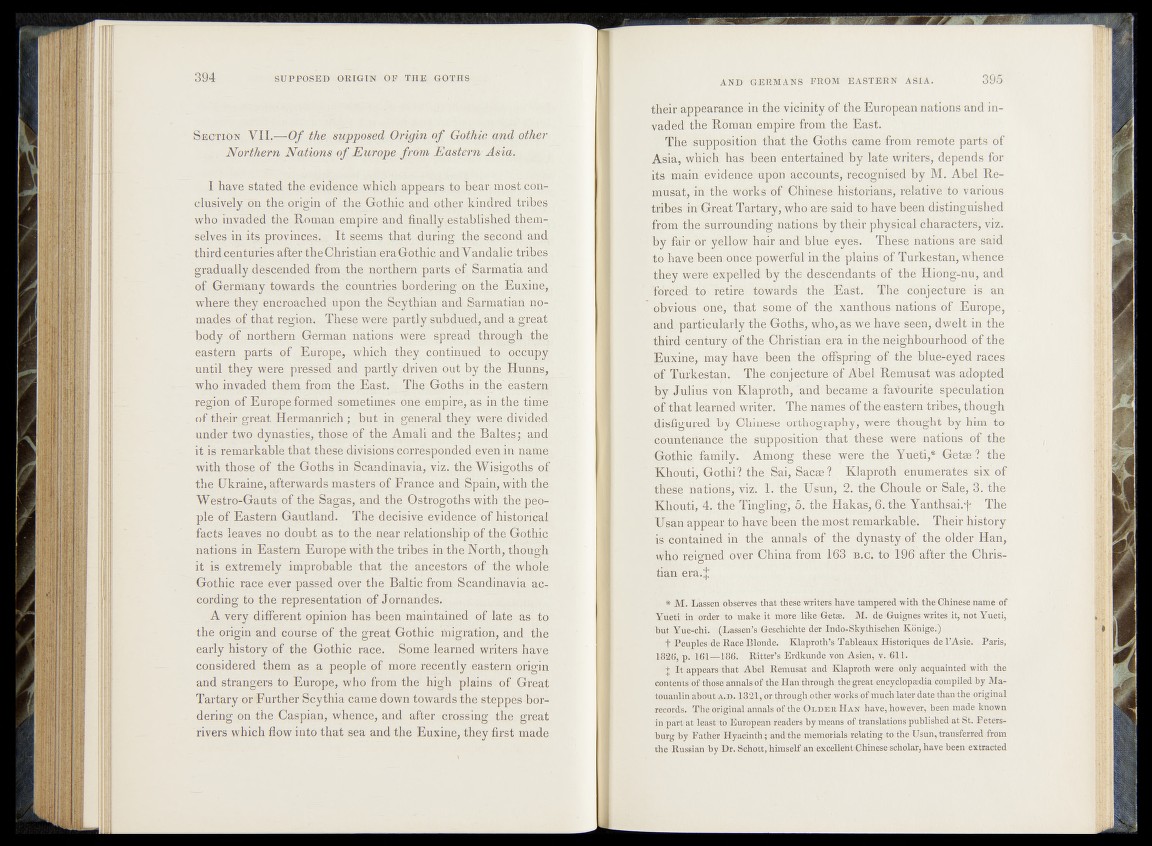
SectiiölN , V ll||l||0 /' the supposed Origin o f Qothic and other,
Northern Nations o f Europe from Eastern Asia.
I have stated; the evidence which appeals to bear, most.coi^-t
clusively on the origin of the Gothic and, other kindred tribef
wppjnyaded the Roman empire apd^naffe^ahRshfid Mem-x •
selves in its provinces, I t seems that during the|agGgrid, and
third centuries after the Christian era Gothic and Vandalic tribes
gradually descended from the northern parts of Sannatia anck
of Germany towards the countries bordering op the JEuxindl
where-they encroached upon the ^Scythian and Sarmati^h pomades
of that region. These were partly subdued, and a g reat
body of northern German nations were spread through -the
eastern parts of Europe, which they,,con1inued tot occupy-,
until they were pressed and partly driven out -by the Hunns,
who invaded them from the East. The Goths in, the',.has,tern,
region,of Europe formpd.sonietimes one-empi-re^psdn the time
of their great llermanrich ; but in general they were ditidddi
under two dynasties, those of the Amali and the Baltes; and
it is remarkable that thése divisipns^eorrèsponded,even in name,
with those of thé Goths in Scandinavia, viz. the \VtsigQ,tlip.©|
the Ukraine, afterwards masters of France and Spain, with the
Westro-Gauts of the Sagas, and the" Ostrogoths with the pep^
pie of Eastern Gautland. The decisive eyiden.ee, qf historical
facts leaves no doubt as to the near relationship of the Gothic,
nations in Eastern Europe with the tribes ,in the North, though
it is extremely improbable that the ancestors of' the whole
Gothic race ever passed over the Baltic from Scandinavia according
to the representation of Jornandem
A very different opinion has been maintained of late as to
the origin and course of the great Gothic rnigration, and the
early history of the Gothic race. Some learned writers have
considered them as a people of more recently eastern origin
and strangers to Europe, who from the high plains of Great
Tartary or Further Scythia came down towards the steppes bordering
on the Caspian, whence, and after crossing the great
rivers which flow into that sea and the Euxine, they first made
their appearance- in the vicinity of the European nations and in-
vadetjythe Roirrarri empire from the East.
Jh e tha$ $iiè 'Qdths came from'remote parts of
Asia^wiftch has ‘been entertained-bydate writers, depends for
its-jmaiff e vfqbqfceVkpoh /açcdbrits^ recognised by M. Abel Re-
mu sat, in' the works o f Chinese hisfrorfâtÉs,bbldtive ,to various
tribe s ' infGJe'àt Tàrtdryà wbd'ate-sâid'to haVehèeh distinguished
from i|re Jéurfiidnding natioDsvBjy their physicalfcharacters, viz.
by'Fair oryfellbw Hair and blue'eyes. ; THes^' nations are said
jtè hnvl&be'en*‘obbêl^owerfùl in the plains! df.Turkestan, whefiee-
Éh«y by the descendants df the Hiqóg-hu, and
Torcedlàt^^feriibï -tèwards! .Vthe bJEa'st. The iilhjèèthre is an
olivid^s ,p'tief th a t1 S0!^ ^ b f the xanthousmatiotiisrof Europe,
afid/partieularly the Goths, who, à£^â.hav#f@çn^ilwel-t in the
third, century of the Christiafi .èrâ ;in the neighbourhood df the
Etixinvy may have -been the qfibpriJpJof the'blu,^-e^drf aces
of Turkestahf^«|fi^ddoj'^t^&,ei®T Mbbl Rbamasat, wasadopted
Julius Von Klaproth, 'and” became a'faVourife speculation
» t h a t learned writer.|me^êmês|pf;tbC’eastbm-tribes, though
®â&gffrèàl by Chinese orthè|raphy, ware thought by him to
i^unteiïanll^^yànppositioh--that;,these;,wefe?nations of ,the
Gothic family.' ‘ Among these yrfere Jthe»j^neti,*i€teteS|Jth^
<|Khodli' Gomi? the, Sai, 'M cm ||l Klaproth enumefifds? six'óf
tlfése''natiöïtëffÿiz. 1. the^Ù^df ^2.'Jthfe Ch o u lè^r-Sale,'’3.-the
KÎiôufi, 4, the 'Tiriglir^^^t^e Hak as, 6. thè Y anthsai.f Thp
Usan appear to have^eqn the most T§fl|arkable. Their history
ipl1 contained in the unnà^ of the dynasty;of'the older Han,
who reigned óver China* from 1*63 ’h x b tn ‘r-O , 9'6 after the Christ
tian era; j
* M. Lassen observes that these writers,hâve tampered with, the Chinese name of
YuetLin-order to tnake'it’f-Jnore ;like,Getæ. -ÜL-defGuignes writes it,&ot Yueti,
but Yue-ehi. (Lassen’s Geschichte der IndosSJ^MsGjien K&nlge^^t
p&t Peuples de Race (Blonde. Klaproth’s Tableaux Historiques d e l’Asie. Paris,
1826, p. I:6!l-—Ï86. Ritter’s Erdkunde yon Asïen, ;v.-'611.
•J I t appears that Abel Reoeusât and Klaproth were only acquainted with the
contents of those annals of the Han through the great encydopædia compiled by Ma-
touanlin about a.d. 1321, or through other wcttlp&ofmuchJater date than the original
records. The original annals of the Oedeb. Hax have, however, been made known
in part at least to European readers by means of translations published at St. Petersburg
by Father Hyacinth ; aUd4he memorials relating to the TJsun, transferred from
the Russian by Dt. Schott,himself an excelleht Chinese scholar, have been extracted